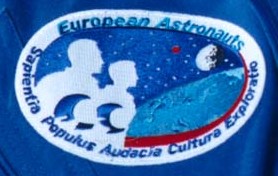

The Charta of the European Astronaut Corps, as signed by the astronauts on 15 August 2001.
The decision in 1998 to form one single European Astronaut Corps was a milestone for Human Spaceflight within ESA and for Europe. It was clear to all of us that a new era of human spaceflight in Europe had just begun and we were a part of it. We realised that it was our task to shape this new era in a truly European spirit and share it with the people of Europe.
This is no minor undertaking. We come from different countries and bring a variety of backgrounds into the European Astronaut Corps, educated as engineers, scientists, medical doctors, or test pilots. We acknowledged that our diversity was a strength in the pursuit of our common goal: peaceful human space exploration for the benefit of humankind at large and for the European people in particular. Although we cherish our origin and our diverse cultural and national backgrounds, we like to see ourselves as true Europeans, who share common European values. And we know that we will be successful only if we work together as a team, a group of people inspired by the same dream about peaceful human exploration of space.
We want to share this dream and our experiences with the people of Europe.
This is why we decided to write a Charta of the European Astronaut Corps: to express and share our vision, our mission and our values with you!
Charta of the European Astronaut Corps
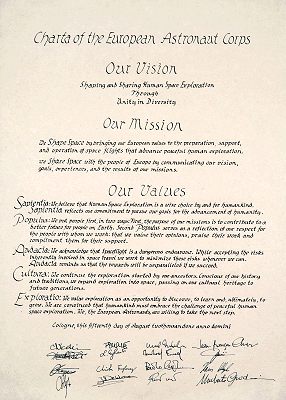 Our Vision:
Our Vision:
Shaping and Sharing Human Space Exploration Through Unity in Diversity
Our Mission:
We Shape Space by bringing our European values to the preparation, support, and operation of the space flights that advance peaceful human exploration.
We Share Space with the people of Europe by communicating our vision, goals, experiences, and the results of our missions.
Our Values:
Sapientia: We believe that Human Space Exploration is a wise choice by and for humankind. Sapientia reflects our commitment to pursue our goals for the advancement of humanity.
Populus: We put people first, in two ways: First, the purpose of our mission is to contribute to a better future for people on Earth. Second: Populus serves as a reflection of our repect for the people with whom we work: that we value their opinions, praise their work and compliment them for their support.
Audacia: We acknowledge that Spaceflight is a dangerous endeavour. While accepting the risks inherently involved in space travel we work to minimise these risks whenever we can. Audacia reminds us that the rewards will be unparalleled if we succeed.
Cultura: We continue the exploration started by our ancestors. Conscious of our history and traditions, we expand exploration into space, passing on our cultural heritage to future generations.
Exploratio: We value exploration as an opportunity to discover, to learn and, ultimately, to grow. We are convinced that humankind must embrace the challenge of peaceful human space exploration. We, the European Astronauts, are willing to take the next step.
Cologne, this fifteenth day of August twothousandone anno domini.
The European Space Agency began its manned flight programme with Spacelab,
providing the opportunity for the selection of the first ESA Astronauts in
1978. The three first astronauts selected were the German Ulf Merbold, the
Dutch Wubbo Ockels and the Swiss Claude Nicollier.
The second ESA astronaut selection was in 1992 in the framework of two major ESA programmes: HERMES (today cancelled) and COLUMBUS. The larger number of astronauts selected and the variety of European nations represented reflected the increased public interest in Europe for manned flight in this period. More than 22 000 Europeans expressed interest in becoming astronauts, including 5500 serious candidates.
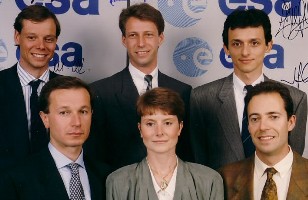 Six candidates were finally selected, including only one previously
selected national astronaut: Jean-Francois Clervoy, the first French member of
the Corps. Also selected were the second German astronaut, Thomas Reiter,
Maurizio Cheli from Italy (resigned in 1996), Pedro Duque from Spain, Christer
Fuglesang from Sweden and the first woman, Marianne Merchez from Belgium who
has since resigned and did not fly.
Six candidates were finally selected, including only one previously
selected national astronaut: Jean-Francois Clervoy, the first French member of
the Corps. Also selected were the second German astronaut, Thomas Reiter,
Maurizio Cheli from Italy (resigned in 1996), Pedro Duque from Spain, Christer
Fuglesang from Sweden and the first woman, Marianne Merchez from Belgium who
has since resigned and did not fly.
On 25 March 1998, the ESA Council decided to build up the single European Astronaut Corps. The objective was to improve the management of the organisation in the framework of the International Space Station programme in which ESA plays a major role. France and Germany, who were the only European countries with a national Astronaut Corps, promoted the idea that the fusion was a good and necessary decision to optimize the astronaut resources.
The details of the Council resolution included: the decision of the constitution of a corps of 16 Astronauts (four for Germany, France and Italy and four for all the other Member States). The integration process would culminate with the dissolution of the national Astronaut Corps at the end of June 2000. This agreement does not exclude the possibility of a Member State using an astronaut of the European Astronaut Corps for a space mission organised at the national level.
The first group of seven astronauts joined the Corps in 1998:
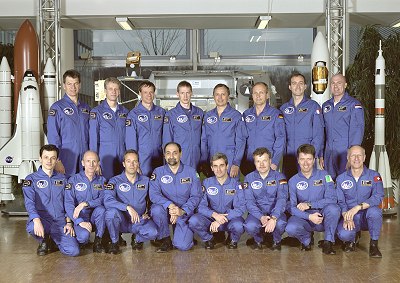
A second group of four astronauts joined in 1999 and included Reinhold Ewald from Germany, André Kuipers from the Netherlands and Claudie Haigneré (formerly André-Deshays) and Michel Tognini from France.
In June 2002 Claudie Haigneré took up the post of Minister for Research and New Technologies in the French government.
Frank De Winne from Belgium joined the Corps at the beginning of 2000.
At the end of 2002, Philippe Perrin from France, became the latest astronaut to join the Corps.
In May 2003, Michel Tognini left the European Astronaut Corps to follow-up Jean-Pierre Haigneré as Head of the Astronaut Division at EAC in Cologne, Germany.
European Astronaut Centre
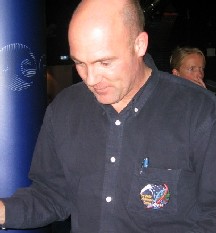
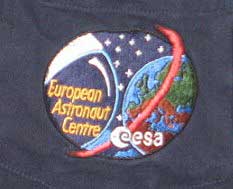
Dutch astronaut André Kuipers wearing the European Astronaut Centre patch on November 7, 2003.
The European Astronaut Centre of the European Space Agency is situated in Cologne, Germany. It was established in 1990 as a result of Europe's commitment to human space programmes and is the home base of the 15 European astronauts who are members of the European Astronaut Corps.
The role of the EAC is to prepare and implement astronaut training programmes for a variety of missions, including those for the International Space Station. It also coordinates astronaut training between ESA and its International Space Station Programme partners.